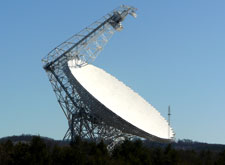Precision Telescope Control System (PTCS)
The Robert C Byrd Green Bank Telescope (GBT) was designed with the plan to improve the telescope's performance over time. The original telescope offered good performance to 22 GHz, but the GBT design provides for much higher frequency performance capabilities.
Enhancing GBT Performance
The PTCS project is a multi-year, multi-phase project to take the GBT to the next level of performance and continue its role as a world-class telescope.
The PTCS project is a series of steps, each building upon the previous step, to improve the measurement, control, and surface accuracy capabilities of the GBT. The early phases of the project are complete and efforts are now focused on the more difficult steps of the project to enable efficient 3 millimeter (110 GHz) operation. The MUSTANG bolometer camera and other new receivers in the development pipeline will readily exploit the enhanced GBT high frequency performance.
The project is broken into multiple sub-projects, working in parallel to achieve the intermediate and long term goals of the PTCS project. The telescope surface is being evaluated and ongoing measurement and capabilities are being developed in the Traditional Holography and Out-of-focus Holography projects. The correction values obtained by these complimentary measurement techniques will be applied to the GBT’s active surface to provide both long term and short term corrections to the surface. The servo replacement project will replace the original analog telescope control system with a new digital servo system, ultimately providing the platform for a model-based telescope control capability.
Performance Goals of the Project:
- See Refined Scientific Requirements for the PTCS by Jim Condon, and especially table 1.
- Ultimate goal is to provide acceptable performance at 115 GHz. (planned Winter 2010/11)
- Intermediate goal is to provide usable performance at 86 GHz for the MUSTANG Bolometer Array (completed Winter 2008/09)
- Early goal is to provide good performance at 52GHz (completed Winter 2007/08)
- The project goals will be achieved by:
- the reduction of the small-scale surface error of the primary reflector,
- improvements to the servo control systems for the primary, secondary and active surface system,
- fielding additional instrumentation and measurement capabilities to more accurately track the performance of the telescope and its environmental conditions
More Information:
Traditional HolographyOut-of-focus Holography
Active Surface
Servo Replacement Project
High-level Project Plan



